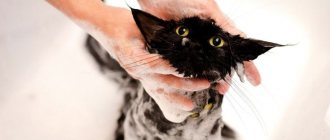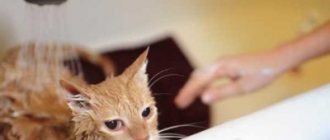Compliance with the rules of pet hygiene is the key to its health. Despite the fact that cats are one of the cleanest animals, it is necessary to carry out water procedures periodically.
It is most important to wash your cat if it has access to the outdoors. During a walk, the fur collects dust, in addition, the pet can become infected with something through spoiled food, dirt and contact with other animals.
When should you wash your cat?
Cats themselves are clean animals, but despite this, experts recommend washing them in the following cases:
- heavy pollution, for example, after walking outside;
- formation of tangles;
- dullness and loss of shine of wool;
- treatment for various parasitic and infectious diseases, as well as allergic reactions using specialized means;
- participation in the exhibition - the animal is bathed using professional cosmetics to make the coat shiny and thick;
- scheduled haircut at the groomer;
- if for some reason the animal is forced to go to the toilet in diapers, you should approach the procedure carefully, since bathing can lead to a worsening of the current disease, so you should consult a veterinarian before carrying out the procedure.
It is worth keeping in mind that many cats are afraid of water. And this is quite natural. Apart from the fact that a wet cat is cold, in this form it is completely helpless, its smell is distinct, and therefore enemies can attack, because the cat is a real predator. We recommend reading the article why cats are afraid of water and what to do about it. To accustom an animal to bathing, experts recommend doing the first one at an early age. It is more difficult to accustom an adult pet to water. In addition, it is important to create comfortable conditions: exclude loud sounds, do everything gradually. Afterwards, for persistence, you should offer the cat a treat or a toy.
What determines the frequency of bath procedures?
Cats naturally love cleanliness. In your free time, you can notice your pet licking its fur. But this is not always enough. A cat can get dirty outside and become infected with fleas from street cats. The frequency of bath procedures depends on several factors.
The first is flea infestation. If your pet has picked up parasites, bathing should be done immediately. You also need to buy a special anti-parasite shampoo.
The cat has fleas
The second is contamination of the fur of a cat that often walks in the yard. There is a lot of dirt, debris and dust on the street. A cat can get into anything sticky, liquid, or dirty. After coming home, the pet will begin to dirty furniture, bedding and carpets. A dirty pet needs to be washed so that the fur does not get tangled in shreds and the apartment remains clean.
The third factor is shedding. Twice a year, cats begin to lose a lot of hair. Pets begin to intensively groom themselves, and the hair ends up directly in the stomach. This is dangerous for the pet. Therefore, the cat needs to be washed so that the dead hairs fall off.
Seasonal cat shedding
The breed of cat affects the frequency of washing. British, Siberian cats, Maine Coons have a fluffy, dense coat. These animals need to be washed more often to keep their coat clean and shiny.
Animals don't like bathing. This procedure is really stressful for them. Therefore, the general well-being of the cat is an important factor influencing the number of such procedures.
There is no exact figure for the frequency of washing. This amount is individual for each pet. You need to take into account the breed of the cat, its lifestyle, and the presence of hair parasites.
How often can you wash a kitten and cat?
Kittens under one year old should not be washed frequently, no more than once a month. If your baby has a bad day and gets dirty, wash only the dirty area, be it paws, butt, etc. If necessary, simply wipe the rest of the wool with a damp sponge.
An adult cat should not be washed unnecessarily more than once every three months during the cold season (i.e., once each in autumn and winter, maximum); in spring and summer, you can wash it a total of four times. However, it should be taken into account that the number of water procedures depends, among other things, on the breed of the animal (length of fur), conditions of detention, and habitat. Thus, cats that do not have hair are bathed much more often than long- or short-haired cats, namely once every two weeks in the summer, and once a month in the winter. Pets are washed more often if they live in large cities, near a highway, or in an environmentally unfavorable area.
Why does a washed weasel fight after the procedure?
Sometimes, after water treatments, pets become aggressive and fiercely defend themselves, attacking the owner or not allowing him to approach them. Usually this does not happen, but some individuals are overly excitable and impressionable. This especially happens if the cat was washed by force or was frightened by something during bathing, for example, a loud sharp sound or a sudden change in water temperature.
Knowing the characteristics of your pet, you can in some cases avoid such behavior. Before water procedures, cats with an excitable nervous system are given a sedative. The drug, its dose and administration order are prescribed exclusively by a veterinarian.
When your pet fights after bathing, you should not force communication on him. It is better to treat your pet with treats, offer an interesting toy, speak in a soothing tone, but do not try to stroke it. When the cat pacifies its ardor, you can gently scratch it behind the ear, gradually establishing contact.
If your cat is stressed during bathing, it is likely that the pet will find it difficult to tolerate further water procedures. Therefore, it is important to behave correctly, adhere to the rules of washing cats and treat your pet with understanding.
When to bathe a kitten for the first time
If you bought a kitten, you don’t need to immediately run to bathe it. Moving to a new house is already stressful for a baby, but here you are with your own shower and shampoos. It's better not to touch it for several months. But if a kitten is found on the street, then it needs to not only be washed, but also treated for external parasites, worms, and taken to a veterinarian.
If the baby is less than three months old, it only needs to be combed, you can wipe it with a wet sponge. If the kitten is purebred and you plan to participate in exhibitions, then bathing can begin at 3-4 months. In this case, it is important to start early, since show-class animals must be accustomed to all kinds of procedures and need to live with them.
Expert advice
Veterinarians and professional groomers advise you to be careful when choosing cosmetics for your cat, and also to bathe in accordance with the general rules. You need to pay attention to the character and mood of your pet, find an individual approach to each pet.
You shouldn't bathe cats too often, but you shouldn't let them get dirty either. It is helpful to create a bathing schedule and stick to it, making adjustments as necessary. If you identify warning signs during bathing (skin problems, parasites), you should not delay visiting the veterinarian and consult with a specialist as soon as possible in order to provide your pet with the necessary help in a timely manner.
What you need to know when bathing a kitten for the first time
So, the rules for the first bath:
- The kitten should be cheerful and cheerful.
- Not hungry, but not just eaten.
- The room should be warm.
In what cases should you avoid swimming:
- Less than two weeks have passed since vaccinations or treatment against external parasites.
- Having recently been spayed or neutered, it is better not to bathe the cat for at least two more months.
- With a large amount of discharge from the ears or eyes.
Don't wake up your baby and immediately put him in the bath. First, play with him, he should be cheerful.
Drying the animal
The freshly washed cat, wrapped in a bath towel, is carried into the room. For long-haired breeds, you may need another towel if the first one gets wet and stops collecting moisture. If the animal is not afraid of the sound of a working hair dryer, then 10 minutes after washing you can start drying. The device regulator is set to warm air - too hot can burn delicate skin.
The next step is to carefully comb the fur and untangle any tangled areas. After water activities, the cat should stay in a warm room for at least 1 hour - otherwise it will catch a cold.
Should cats be washed? This is an interesting question to which not everyone knows the answer. Hygiene measures are often unpleasant for both the pet and its owner. But sometimes it is impossible to do without them. Compliance with washing rules will reduce discomfort in the animal and prevent stress. After each bath, your furry pet should be treated to a special treat for cats - it will calm him down and increase the level of trust in his owner.
How to prepare a cat for a bath
Before carrying out the procedure, it is necessary to prepare the work space: place shampoo and a large terry towel within easy reach. You should also set a comfortable water temperature - about 39 degrees. Under no circumstances should you wash your pet in cold or hot water.
To reduce the noise produced by water, you should first fill the bath with a small amount of water and also reduce the shower pressure, in which case the cat will experience less stress and will tolerate bathing better. The ideal option is to stop using the shower. To do this, you need to prepare a sufficient amount of warm water and a ladle or small saucepan with which you can water your pet.
About one day before the planned bathing, it is recommended to comb your pet thoroughly so that if water gets in, lumps and tangled strands do not form.
If the cat is about to have its first bath, it is necessary to calm it down and avoid loud noises and screams that could frighten it. It is also recommended to carry out the procedure together - one person holds it, the other washes it.
It is recommended to place a rubber mat or terry towel at the bottom of the bath to prevent the cat from slipping on it.
Before placing the cat in the bathroom, shampoo is poured into a specially designated container and diluted in water to form abundant foam.
Final verdict
Regular baths will keep your pets free from germs and of course play an important role in maintaining a healthy indoor environment. But here it should be remembered that the same rules do not apply to cats of all ages. Follow the bathing instructions we mentioned earlier. If possible, apply a special paw shampoo and lotion. Rather, do not spoil your pet during bath time unless it will cause stress. As a result, he will also become sick and afraid.
In conclusion, regular grooming and washing will keep your cat in good and healthy shape. Hope your happiness will be bright with your cute pet cat.
Mr. Cat recommends: what products to use to bathe a cat
In order not to harm the condition of your pet’s fur and skin, you need to choose the right shampoo.
- Shampoo is available for oily and dry skin. In the latter case, they reduce the formation of static, add shine, and nourish. Some products contain sebum, that is, a fat-like substance that is secreted by the sebaceous glands, as a result of which the coat is covered with a protective layer. If your pet has oily skin, shampoo helps remove excess oil.
- If your pet has unkempt fur, you should choose a shampoo to remove tangles. The mechanism of action is that positively charged components come into contact with negatively charged hairs, causing the clumps to unravel. The product also gives a healthy shine and elasticity to the coat.
- Tinting shampoo is usually used in preparation for an exhibition to give the coat a pronounced shine and deepen the color. Such products contain coloring pigments that interact unstable with the hair, due to which they are gradually washed off from the pet’s fur. The use of such shampoos for bathing spotted cats is not recommended, as the white areas of the coat may lose their color.
- Lightening agent is used to whiten stains. Most often used before an exhibition.
- A special shampoo for breeds without hair, designed for high-quality skin care. Such products are presented in small quantities on the domestic market, and are also high in cost, so they can be replaced with children's hypoallergenic shampoo.
- Specialized medicinal shampoos are prescribed by a veterinarian to treat skin infections, treat fleas and lice.
For cats that really don’t like to wash themselves, spray or dry shampoos have been created. It is enough to spray them on the wool, and after a few minutes comb it.
Cat bath products are used according to the instructions; if side effects occur or if the contents get into the eyes, ears or nose, you should contact a veterinarian.
Interesting Facts
Most people know that a cat is a clean creature. She will be able to carry out hygiene procedures on her own, licking herself with her tongue. Kittens learn this process by watching older cats. Also, independent cleansing is incorporated as a reflex, a kind of “genetic memory”.
Cat hair has a natural coating that is produced by the sebaceous glands, which is why dirt does not linger on it.
All these features give rise to questions and doubts about how often to bathe cats, whether they can be washed at all, and what products to choose. Each of them must be studied in detail.
Features of washing different breeds
Sphynx cats do not have hair, as a result of which their skin is prone to excessive oil production, so it is recommended to bathe cats of this breed more often than others - from 7-9 times a year to once every 2-6 weeks. Between baths, you can wipe your skin with damp hypoallergenic wipes.
You can understand whether a hairless cat needs to be washed by the following signs:
- unpleasant odor;
- fatty deposits on the skin, stickiness;
- dirt in the folds.
Long-haired and semi-long-haired breeds require less frequent bathing. So, Persians and Sibiryaks are bathed once every 1.5-2 months, or even less often. It is recommended to use a shampoo depending on your skin type, as well as a conditioner that prevents the formation of tangles.
Short-haired cats, such as Britons, Scots, Bengals, etc., do not need to be bathed at all, but in general it is better to do this unless absolutely necessary, no more than once every 4-6 months.
1111
Some prejudices
There is a category of owners who claim that cats should not be washed at all. Some explain this by saying that water is destructive for these animals, which is why cats avoid it on an instinctive level, while others believe that since a cat licks itself every day, this is absolutely enough for it to maintain cleanliness.
In fact, such a judgment is incorrect. Almost all cats do not like water, since this is not their natural environment and the feeling of being wet and cold is very unpleasant for them. Pets are especially frightened by the flow of water rumbling in the shower, since cats’ hearing is much sharper than that of humans and the noisy hissing flow makes them nervous, associating them with danger. Cats consider water to be something destructive, but moisture does not pose a threat to them. On the contrary, sometimes bathing is simply necessary for your four-legged friend.
Bathing a cat in the sink
In fact, cats are good swimmers; there are some that happily splash in the water, play and bask in the shower. This is normal, although unusual.
There is no need to worry about this and you can easily allow your pet to have plenty of contact with water. It is only important to make sure that after such procedures the pet does not freeze.
Other owners fanatically wash their pets almost every day, in order, in their opinion, to keep the pet’s beautiful fur clean, give it a pleasant aroma and an attractive shine. The result of such care can be disastrous - skin irritation, wounds, ulcers, dandruff and flaking, dullness, hair loss and many other health problems.
Any extremes in caring for pets are inappropriate. Wrong attitude and lack of necessary knowledge often harms the health of the pet. It is also important to take into account the breed of the cat and select cosmetics and a bathing schedule for each individual. An attentive owner always has questions while keeping a pet, so do not hesitate to seek advice from a professional.
Where to go in Rostov-on-Don?
- Salon Matilda. Address: st. 1st Cavalry Army, 15th century.
In addition to a wide range of grooming services, the salon is a school for master groomers. Specialists from different cities of Russia flock here for primary training and advanced training.
- Zoo. Address: st. 1st Cavalry Army, 15th century.
All procedures are performed without the use of anesthesia or sedatives. Promotions are held periodically and you can get discounts on services. Pre-registration available. It is better to clarify the details by calling the salon.
Read other articles on the Guardian of Purity portal. We care about the health of our four-legged friends. Stay with us!
Quantity











